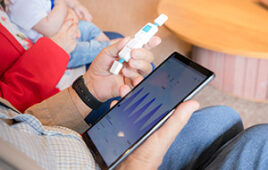 The U.S. Prescribing Information for Jentadueto (linagliptin and metformin hydrochloride) tablets now includes clinical trial data that showed linagliptin co-administered with metformin provided statistically significant decreases in blood glucose compared with linagliptin alone in treatment-naive adults with type 2 diabetes and high baseline A1C levels (A1C of > /=8.5 to < /=12%). Boehringer Ingelheim Pharmaceuticals Inc. and Eli Lilly and Co. announced that the data, based on results from a prospective 24-week Phase 4 clinical trial, have been added to the “Clinical Studies” section of the Jentadueto U.S. Prescribing Information.
The U.S. Prescribing Information for Jentadueto (linagliptin and metformin hydrochloride) tablets now includes clinical trial data that showed linagliptin co-administered with metformin provided statistically significant decreases in blood glucose compared with linagliptin alone in treatment-naive adults with type 2 diabetes and high baseline A1C levels (A1C of > /=8.5 to < /=12%). Boehringer Ingelheim Pharmaceuticals Inc. and Eli Lilly and Co. announced that the data, based on results from a prospective 24-week Phase 4 clinical trial, have been added to the “Clinical Studies” section of the Jentadueto U.S. Prescribing Information.“We are extremely pleased with the addition to the JENTADUETO label. These data support the use of JENTADUETO as an initial type 2 diabetes treatment option in an important patient population- treatment-naive adults who have high baseline A1C levels,” said Christophe Arbet-Engels, vice president, metabolic clinical development and medical affairs, BIPI. “In addition, these data reinforce the use of JENTADUETO, as an adjunct to diet and exercise, in helping adults with type 2 diabetes improve glycemic control.”
The 24-week, randomized, double-blind study assessed the efficacy and safety of linagliptin (5 mg per day) in combination with metformin (1500 to 2000 mg per day; n=159) vs. linagliptin (5 mg per day; n=157) alone in treatment-naive adults with type 2 diabetes and high baseline A1C (A1C of > /=8.5 to < /=12.0%).
The primary endpoint of the trial— change from baseline in A1C after 24 weeks— demonstrated that initial therapy with the combination of linagliptin and metformin reduced A1C levels from baseline by 2.9% compared with 2% for linagliptin alone. There was a statistically significant mean difference in A1C between the combination and linagliptin alone of -0.84%. Key secondary findings showed fasting plasma glucose (FPG) levels were significantly decreased with the combination treatment compared with linagliptin alone (54 mg/dL vs. 35 mg/dL, mean difference -18 mg/dL) and that a greater percentage of patients achieved an A1C less than 7% with the combination of linagliptin and metformin (54%) compared with linagliptin alone (30%). The percentage of patients with investigator-defined hypoglycemic events was similar between treatment arms (linagliptin and metformin, 1.9%; linagliptin, 3.2%).
Date: August 4, 2014
Source: Lilly




